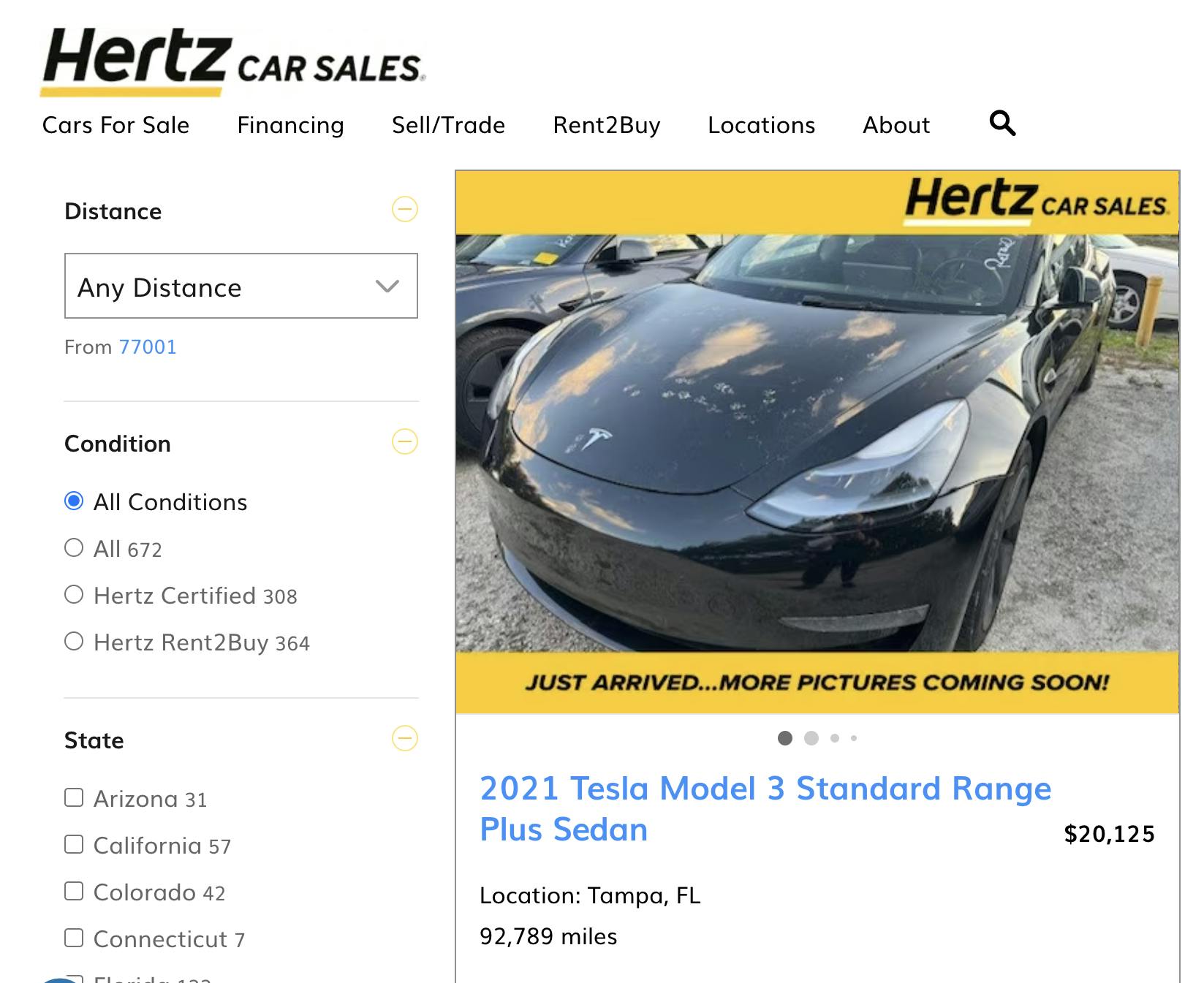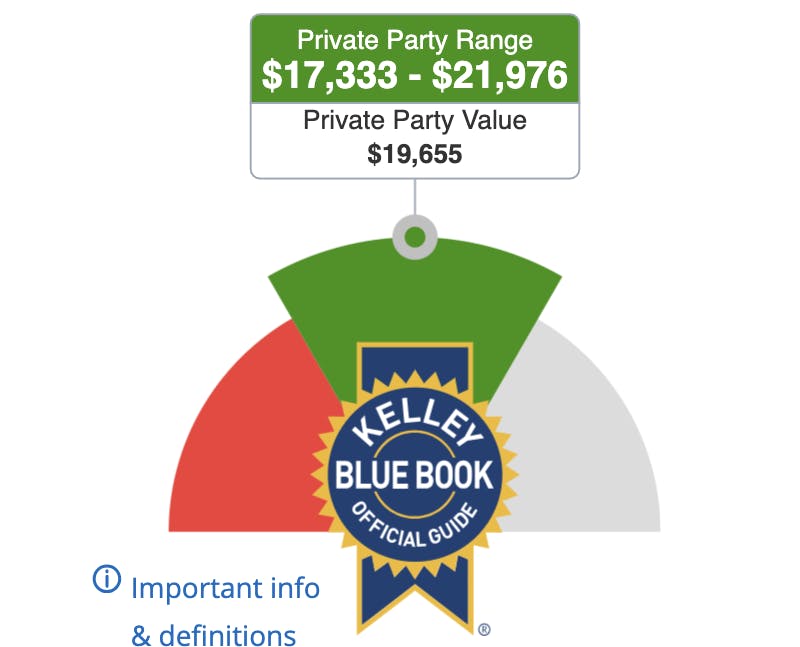Hertz to Sell 20,000 EVs and Replace with Gas Vehicles
Hertz has announced a plan to thin its fleet of electric vehicles by 20,000 units and replace them with gasoline-powered vehicles, citing lower than expected demand and higher repair costs. Bloomberg reports they have already began the process of selling their inventory.
Overall EV demand has not met lofty sales expectations, as sales growth was only 1.3% higher from the third to fourth quarter of 2023. In an interview with CNBC, Hertz’s CEO Stephen Scherr said EV rentals are “not at the level of demand that we anticipated.” EVs have also been more expensive to repair than gasoline vehicles in Hertz’s fleet, and Sherr suggested that “efforts to wrestle it down proved to be more challenging.” CNBC also did a credible job explaining the how and why this strategy failed.
The video suggests that routine maintenance costs were lower for EVs, but repairing accident damage is twice that of a gasoline vehicle. Tesla vehicles are sometimes associated with uneven parts and service support, and a quick scan of Hertz Car Sales’ website shows that they are currently selling 672 Teslas, 35 Chevrolet Bolts, 3 Kia EV6s, one Nissan Leaf, one BMW i3 from 2018 (!), and none of their Polestar EVs.
What does this mean for you?
More Teslas will be dumped onto the market in the coming months, which may affect already depressed prices. Currently, Hertz’s cheapest Tesla is this black Model 3 with the standard battery. It is fairly priced at $20,125, roughly 57% less than its original asking price of $46,440 back in 2021. The cheapest 2021 Toyota Prius that Hertz is currently selling is $18,300 (with no photos, possibly in worse shape than the Tesla), which is only a 28% loss in value in a similar timeframe.
Because EV production is lowering to match this slower than expected growth, Hertz’s market correction could be the best time for EV-intenders to get into the game before supply fully adjusts to demand. If that’s what you really want.
***
Check out the Hagerty Media homepage so you don’t miss a single story, or better yet, bookmark it. To get our best stories delivered right to your inbox, subscribe to our newsletters.





I rented a Tesla 3 from Hertz this past year in DC. I would be there for a weekend family event, drive less than 100 miles so no range-anxiety, I knew the parking garage had chargers, and public transportation was not an option for multiple event locations. I made sure to ask the efficient rental agent how do you make sure you return a BEV “fully charged?” I was told within 20% would be fine. It took me 20 minutes to familiarize myself with unique operation, and I have test-driven a Tesla 3 within the past 12 months. Systems would not fully sync with Android for “car-play.” Tesla navigation was slow and overall poor. The rental car key “card” was awkward. Garage charging stations had been removed, and the nearest Tesla was several miles away. This didn’t matter, since I had no Tesla charging account. I returned the car slightly below 80% and was told no problem given the problems. My emailed bill reflected an additional $35 charge due to being not fully charged. I let them know I would never rent another BEV. But for Tesla owners who are familiar and have a BEV charging account, there is a demand for BEV rentals. BEV sales in 2023 went from 1-2% of sales to over 5%. Hertz stepped up to try, took advantage of Federal & State rebates for BEV, and offered the BEV at a lower rental price than a Hybrid or ICE vehicle. The Tesla 3 is a blast to drive, does most everything well, and I experienced none of the quality concerns expressed elsewhere.
Al Gore
Waiting in line at rental counter, man in front of me was a gold member complaining about his electric vehicle they were trying to give him, asking about changing, the 120v charging cable in trunk and this was the best part before he said NO! You need to return car with 70 percent charge or they will “charge” you an additional fee! He drove away in an ice vehicle!
It is not a hoax. Get off the kool-aid.
Absolutely right Bob. Asking anybody who is farming right now if they think that it is a hoax. With the weather that we have had in the Great Lakes basin, an area that used to have a safe, moderated climate, farming is now an adventure, not for the faint-hearted. Don’t drink the Kool-Aid.
The Kool-aid drinkers are the people that believe in “climate change” as some sort of threat to humanity. It has to difficult going through life this gullible and so easily manipulated.
But Bob . . . the CO2 Hypothesis is still Unproven Science after 30 years . . .
The weather you are experiencing has happened before . . . we are neither hotter of colder today than we have been in the past. We are now experiencing a Maunder Minimum much like the early 18th century.
Weather is measured in days & weeks . . . Climate is measured in Decades & Centuries.
Check back 50 years ago. Exxon-Mobil internal research in the late 70’s on the impact of fossil fuels on climate change were very accurate, surpassing the findings of even some academic and government scientists. Have a look at the Harvard Gazette (1/12/23).
Sounds like you have had a few glasses yourself
So, when the time comes and it’s profitable to release the truth to the public that an ultra-fuel efficient very small engine with a small battery is all that is needed to power the electric motor in a hybrid vehicle. And that a simple onboard converter will separate water into hydrogen and oxygen which already exists, but is not allowed to be available yet, people will own EVs for a few years until they are practically worthless.
In the early 60s I drove an electric forklift, It was fine until the battery started to run out. It would sometimes not make it back to the charging station. It would take about 8 guys to push it back to the station and then wait hours for it to recharge. Meanwhile, manual pallet jacks had to be used to move the product around. My point is, we are simply not there yet when it comes to battery technology. Battery operated vehicles were around in 1917, same problem, batteries. Will there be a good solution to this problem? Hopefully, meanwhile, it is ICE for me. If you still want to feel all environmental and do your part, paint your boat anchor lime green and drive slow in the fast lane.
Eerybody always talks about the E.V. batteries ONLY, what about the armatures ,bearings ,windings, voltage
regulators, if going to D.C. diode trios etc. stuff like that can not be compared and last like the systems of the ICE engines
look at the modern DIESEL engines ex(Bluetec ) you can inhale their exhaust .My dear friends it does not pay to listen to bureaucrates and jounalist in Mechatronic science. So there!!
It is clear that mastery of written communication is not a priority in European education
until electric motor vehicles are powered by something that makes sense and isn’t incredibly destructive to the environment i want nothing to do with EVs or hybrids for that matter.
as kid rock said in Joe Dirt, “nobody wants you around Joe Dirt (EV)”
A proud owner of a Nissan EV in Vancouver BC hit an object on the road . . . he was concerned he might have done some damage so he went to his Dealer. Turned out there was damage to the Battery Envelope . . . the Dealer said the Battery was compromised and needed to be replaced. The customer was quoted $60,000 for the Battery replacement. The guy was floored, he paid less than that for the car NEW.
So he went to his Insurer and they Wrote Off the Vehicle. The story broke in the Media and of course Nissan wanted the car back to check it out. The Insurance Company said NO, it’s now our car.
He could have bought an ICV for $10,000 less and none of this would have happened and saved the world the big Karbon Footprint of the now dead EV.
Please remember that we use a crazy amount of fossil fuel to mine the materials for the batteries and even more to make the electricity to charge them. Please tell me how we are saving the planet by using more fossil fuel to go all electric.
And that’s the fact, Jack!
We recently purchased a Chevy Bolt that was parked for some time while awaiting a battery replacement that was recently done by GM. Paid a net of $13000 for a car with 30K miles and a new battery with an 8 year/100,000 mile battery warranty. It costs 1/4 of the car it replaced to drive to work daily. We had a 240 outlet already in the garage for a welder I never purchased, so installation was not an issue. If you have a garage, a means of charging, and a reasonable drive to work or for shopping, an EV can make sense. Otherwise, I don’t think it does for most consumers. I don’t think public chargers are the solution. If I had to rely on them, I wouldn’t consider an EV.
I’m not an Uber driver and I don’t own an EV, but I have a serious question, especially for someone that is an Uber driver with an EV. The video said the average Uber driver drives about 1500/week. If they work five days, that is 300 miles/day. From what I see about EV ranges that 300 miles is either right at or exceeds the range of most EV’s, especially in cold weather. So how does that work if you have to stop and charge before your day is up? Isn’t that going to take you out of the rotation for around an hour? I assume that is a big hit to take for an Uber driver. If you can make it the full day and charge overnight, I can see how that would work, but at 300 miles that seems like you could be right at the limit.
Uber drivers usually take a break at or near a charging station, and it only takes a 10-20 minute break at a Tesla supercharger to get enough to finish the day. The other perk is they lose almost no range while idling/waiting for a fare, getting stuck in traffic, waiting for a customer to walk outside and get in the car, etc.